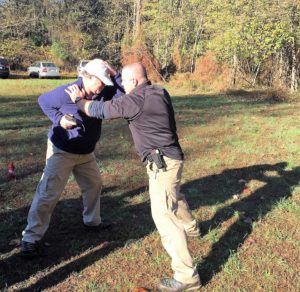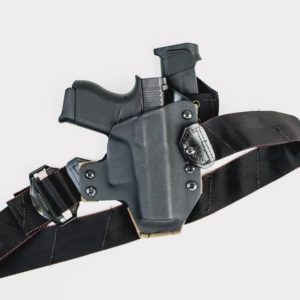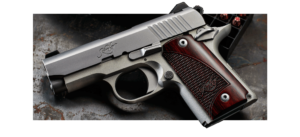Written by: Greg Ellifritz

Working with a student to develop a stable close quarters fighting platform
Last Saturday John Murphy from FPF Training hosted me for a one-day Extreme Close Quarters gunfighting class down in Culpeper Virginia. As expected, John’s students were great, the facilities were excellent, and the logistics were sorted properly. The 20 students and I had a good day of training.
Here are a couple of issues that I noticed in class….
Gun fit is important. What I mean by “gun fit” isn’t “this gun feels good in my hand.” Although that factor seems important to novice shooters, it really doesn’t affect most people’s ability to use the firearm. Subjective “feel” shouldn’t be a primary determining factor in your defensive firearm choice.
What I’m talking about with regard to “gun fit” is the issue of how well you can reach the necessary controls. I had a small female student carrying a CZ-75 cocked and locked in class. The gun functioned without a hiccup. The problem was that she couldn’t disengage or engage the safety with her dominant hand. Her thumb was simply too short and the pistol’s grip diameter was too large. She struggled all day because she had to use her support hand to operate the safety. She found out that there are fighting situations where that support hand is critically needed for doing something else (like stopping an opponent’s draw or blocking his punch).
I have no problems if a person likes and carries a CZ-75. I do have a problem if you show up to class with a gun that is too big or too small for you to operate safely with only one hand. I worry even more when you carry that gun defensively.
Even the small guns ran well in this class. After a class I taught last month, I wrote about how compact pistols like the S&W Shield or the Glock 43 were slightly less reliable than their full sized brothers when shooting from a retention position. I still believe that fact is generally true, but I didn’t see any issues in my most recent class. I saw very few malfunctions overall, even with the smaller guns.
I found a useful bellyband style holster for women. I will be the first to admit that I am not the best person to ask for information about the “best” holsters for female concealed carry. I can tell you what I have seen my students use successfully in class, but as I am not a female, my advice should be taken with a grain of salt.
With that said, a female student in my class was running a rig that I had not yet seen before. It held up well in class and she really liked it. The holster is from a small kydex gear shop called Runcible Works (link is to their Instagram page). The “YP” holster (for “Yoga Pants”) is a well-designed kydex holster mounted on a sturdy nylon belt, designed to be carried like a belly band.
I don’t really like a lot of belly bands. The traditional holsters or pouches in which the gun is carried are not durable and make reholstering under stress difficult. This one is very different.
My student was carrying a Glock 43 with extended magazine base plate and a spare mag at the 12 o’clock position with the gun grip just above the waistband of her jeans. She didn’t need to have an additional belt. The gun disappeared under her form-fitting button-up shirt. There were no safety or access issues. She successfully completed a fairly intense fighting class with lots of draws under pressure while fighting a resisting opponent and I never saw any issues with her gear or holster.
This one looks like a good option for you ladies who want to carry without a belt.
I had to eat crow. One of my students showed up in class carrying a Kimber Micro 1911 in 9mm. When I saw it, I thought to myself “there is no way that gun will make it through this class.”
Although there are notable exceptions, I usually see the following things in my classes:
- 1911 style pistols have more feeding problems than a modern striker-fired pistol
- 9mm 1911s are less reliable than .45 acp 1911s
- Compact 1911s are less reliable than full-sized 1911s
- With regards to all of the 1911s that I see, I observe the most failures in guns manufactured by Kimber
- Small pistols of any make or model are more likely to malfunction when fired from retention or without an extremely strong grip
With all the criteria listed above, one might think that the 9mm Kimber Micro 1911 would be an absolute failure in the reliability department. Almost every single factor that reduces a 1911’s reliability is present in the Kimber Micro. At the start of the class I was worried.
I’m happy to report that this sample Kimber Micro was good to go. My assumptions were wrong. The Micro had a couple malfunctions in the 200 round course, but all were magazine related. The gun always jammed immediately after firing the fifth round when using one of the student’s practice magazines. Since the malfunction was so consistent and repeatable, I’m inclined to think “bad magazine” instead of “bad gun.” When the student stopped using the particular magazine in question, he didn’t have any further malfunctions.
I generally have a visceral hatred of Kimber 1911s. This Micro was definitely an anomaly. I have to give credit where credit is due. This particular Kimber Micro was as reliable as any other gun on the line.
Don’t run out and buy a Kimber based solely on this advice. My best guess is that the student’s gun is a statistical outlier, but I’m encouraged when I have any Kimber make it through one of my classes. I’m hopeful that Kimber has worked out some of their original issues and that the pistols Kimber produces in the future become even more reliable.



